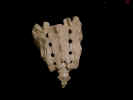

 Anterior view
Anterior view Posterior view
Posterior viewThe sacral vertebrae are the most unusual of them all. There are five sacral vertebrae and they are all fused. Actually, fusion begins after puberty and is complete by the time a person is 30 years old. Part of the structure is the remains of the sacral ribs, which fuse to the vertebrae during development. The vertebral foramina join to form a canal within the sacrum, terminating inferiorly as the sacral hiatus. There are four pairs of anterior and posterior sacral foramina that allow the sacral rami to exit from the sacral canal. Superiorly the sacrum articulates with the fifth lumbar vertebra. Inferiorly it articulates with the coccyx. Laterally it articulates with the ilium. The anterior edge of the body at the superior end of the sacrum projects anteriorly into the pelvic cavity. This is called the sacral promontory. The sacrum forms part of the pelvic wall. The sacrum has a concave anterior surface and convex posterior surface, this being the sacral curve. The flat surfaces of the sacrum are important as areas for muscle attachment for muscles of the thigh and lower back. The sacrum is usually shorter and wider in women than in men. We will spend more time on the sacrum in lab 11.
COPYRIGHT
2007 by William C. Johnson II
ALL RIGHTS RESERVED!